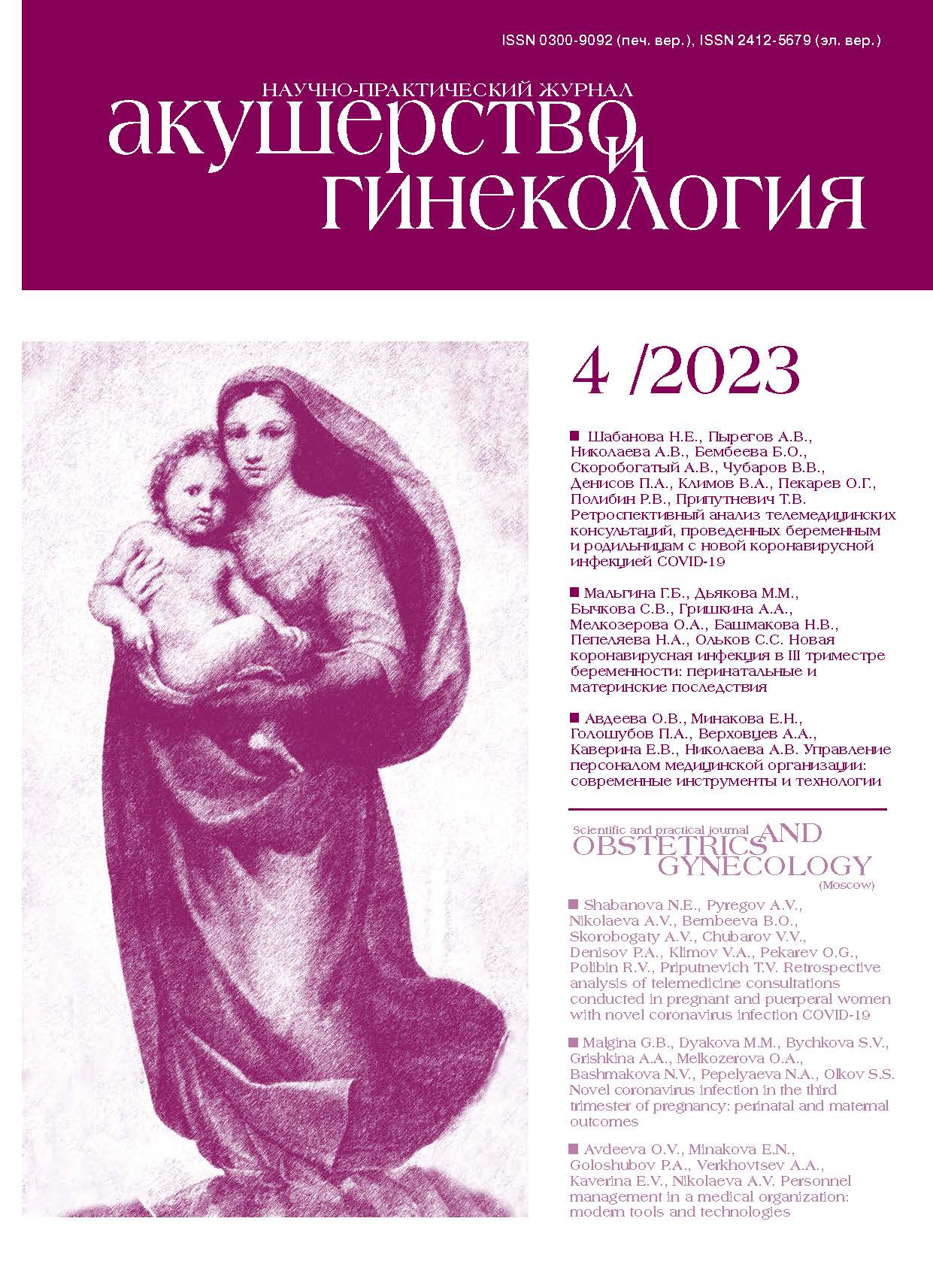Personnel management in a medical organization: modern tools and technologies
- Authors: Avdeeva O.V.1, Minakova E.N.1, Goloshubov P.A.1, Verkhovtsev A.A.1, Kaverina E.V.2, Nikolaeva A.V.1
-
Affiliations:
- Academician V.I. Kulakov National Medical Research Center for Obstetrics, Gynecology and Perinatology, Ministry of Health of Russia
- Peoples’ Friendship University of Russia, Medical Institute
- Issue: No 4 (2023)
- Pages: 120-131
- Section: Exchange of Experience
- Published: 30.05.2023
- URL: https://journals.eco-vector.com/0300-9092/article/view/462789
- DOI: https://doi.org/10.18565/aig.2023.3
- ID: 462789
Cite item
Abstract
Relevance: A loyal, engaged and satisfied employee is more productive and influences positively the overall productivity and success of the organization.
Objective: To study the characteristics of employees that directly affect labor productivity using three evaluation indicators (loyalty, engagement and satisfaction); information technology use is taken as an example.
Materials and methods: The research process was modeled using an empirical method. During the observation, an experiment with the use of information technologies was carried out.
Results: Corporate survey with the use of information technologies allowed us to computerize and correctly evaluate 1009 respondents. The analysis of qualitative and quantitative indicators followed the survey which helped us to understand the characteristics of the personnel, their productivity, attitude and loyalty to the organization.
Conclusion: The above methodology makes it possible to evaluate personnel in the shortest possible time, change the content of questionnaires for specific goals and objectives of the organization, create a database of the most productive employees or identify negative factors, evaluate the behavior of an employee in real situations in the future. This technique helps to remove numerous routine tasks from human resources managers, make their time free for solving other issues, thereby allowing them to be closer to employees, react faster to changes in the team, analyze data and manage human resources more successfully.
Full Text
About the authors
Oksana V. Avdeeva
Academician V.I. Kulakov National Medical Research Center for Obstetrics, Gynecology and Perinatology, Ministry of Health of Russia
Author for correspondence.
Email: o_avdeeva@oparina4.ru
Chief Nurse
Russian Federation, MoscowElena N. Minakova
Academician V.I. Kulakov National Medical Research Center for Obstetrics, Gynecology and Perinatology, Ministry of Health of Russia
Email: e_minakova@oparina4.ru
Deputy Chief Physician for Work with Medical Personnel
Russian Federation, MoscowPetr A. Goloshubov
Academician V.I. Kulakov National Medical Research Center for Obstetrics, Gynecology and Perinatology, Ministry of Health of Russia
Email: p_goloshubov@oparina4.ru
Russian Federation, Moscow
Andrey A. Verkhovtsev
Academician V.I. Kulakov National Medical Research Center for Obstetrics, Gynecology and Perinatology, Ministry of Health of Russia
Email: verhovtsev@oparina4.ru
Russian Federation, Moscow
Elena V. Kaverina
Peoples’ Friendship University of Russia, Medical Institute
Email: kaverina-ev@rudn.ru
ORCID iD: 0000-0002-0264-8543
PhD, Associate Professor, Department of Public Health and Hygiene, Medical Institute
Russian Federation, MoscowAnastasia V. Nikolaeva
Academician V.I. Kulakov National Medical Research Center for Obstetrics, Gynecology and Perinatology, Ministry of Health of Russia
Email: a_nikolaeva@oparina4.ru
Chief Physician
Russian Federation, MoscowReferences
- Dantseva D.S. Modern methods of personnel management of the organization. Young Scientist. 2017; (40): 106-8. (in Russian).
- Obydenov A.Yu. Agile management methods in modern organizations. Creative Economy. 2021; 15(11): 3989-4008. (in Russian). https://dx.doi.org/ 10.18334/ce.15.11.113834.
- Romantsova O.N. Personnel as the main resource of any organization. Young Scientist. 2020; (18): 135-8. (in Russian).
- Klochkov A.K. Personnel involvement and loyalty from A to Z. Moscow: Eksmo; 2022. 240 p. (in Russian).
- Pushkina A.S. The study of personnel involvement by the example of a large telecommunications company: specification of the concept, the relationship with job satisfaction. Young Scientist. 2016; (11): 923-8. (in Russian).
- Kharchenko V.S. Social well-being of the organization's personnel: methods for studying the main hr indicators (satisfaction, involvement, loyalty and motivation). Managing Culture. 2022; (2): 4-15. (in Russian).
- Korgina O.A., Suchkova E.E., Danilova N.E. Genesis of the theoretical approaches in human resource management of the organization. RJOAS. 2017; 5: 38-45. (in Russian). https://dx.doi.org/10.18551/rjoas.2017-05.06.
- Bekirova E.A. Innovations in the organization of labor activity and personnel management. Modern management: trends and prospects for development. Simferopol: IP Khoteeva L.V., 2021: 103-8. (in Russian).
- Okhotnikova L.Kh. Determination of the effectiveness of management decisions. Transport Business in Russia. 2006; (12-3): 73-6. (in Russian).
- Kazaryan M.M. Effectiveness of human resources management in a company (by the example of LLC "Gazprom Invest"). Economics, management, finance: proceedings of the VII International Scientific Conference (Krasnodar, February 2017). Krasnodar: Novatsiya; 2017: 84-7. (in Russian).
- Ferreira C., Reis Neto M., Vasconcelos F., Souki G. Motivation and rewards to health professionals. Gestão & Planejamento. 2016; 17(1): 41-58. https://dx.doi.org/10.21714/2178-8030gep.v17i1.3534.
- Pengpid S., Skaal L., Sebokane M., Matla T. Factors influencing job satisfaction among healthcare professionals at South Rand Hospital. Published 2010. Medicine. https://www.semanticscholar.org/paper/FACTORS-INFLUENCING-JOB SATISFACTION-AMONG-AT-SOUTH-Pengpid Skaal/877053c144d7b301b57a5bc488a33e60531bf268.
- Koroleva Yu.M. Modern technologies in HR. Young scientist. 2019; (28): 70-2. (in Russian).
- Agafonova M.S., Klimacheva A.K., Gaidar K.O. The use of information technology in personnel management. Scientific-methodical electronic journal "Concept". 2017; 39: 546-50. (in Russian).
- Trysyachny V.I. Peculiarities of consideration of the system of organization controlling. Modern Science. 2022; 3-1: 68-71. (in Russian).
- Volkov I.V., Kizlova K.R. Modern approaches to digitalization of hr management in communication organizations. Young Scientist. 2021; (16): 154-9. (in Russian).
- Yavorsky N.K. Digital technologies in the system of personnel management. Young Scientist. 2020; (19): 260-2. (in Russian).
- Zhumalieva A.K. Comparative analysis of the domestic and foreign model of personnel management. Young Scientist. 2020; (2): 263-6. (in Russian).
- Unterweger M., Имхоф С., Мор Х., Römpler, M., Кубик-Хуч Р.А. [Какие факторы влияют на удовлетворенность работой и мотивацию в институте радиологии?]. Praxis (Bern 1994). 29 августа 2007; 96(35):1299-306. https://dx.doi.org/10.1024/1661-8157.96.35.1299.
- Tokareva Yu.A., Glukhenkaya N.M., Tokarev A.G. Motivation of labor activity of personnel: an integrated approach. Monograph. Shadrinsk: ShHPU; 2021. 216 p. (in Russian).
- State of the Global Workplace: 2022 Report. Available at: https://www.gallup.com/workplace/349484/state-of-the-global-workplace.aspx?thank-you-report-form=1
- Zlygostev V.Y. Management in Japanese. Peculiarities of personnel management and labor motivation system in Japanese personnel management in modern Japanese enterprises. Moscow: Publishing House of Academy of Natural Sciences; 2016. 194 p. (in Russian).
- Shatalova-Davydova D.A., Zolotov R.A. Foreign methods of personnel management. Young Scientist. 2018; (31): 63-4. (in Russian).
Supplementary files
























